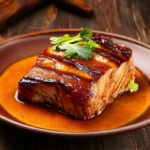Exploring the Flavors of Canton: Steamed Sea Bass with Ginger and Scallion
Introduction
Cantonese cuisine is renowned for its emphasis on fresh ingredients, minimal seasoning, and delicate flavors. Among the many classic dishes, steamed sea bass with ginger and scallion stands out as a quintessential representation of Cantonese culinary artistry. This dish not only showcases the simplicity and elegance of Cantonese cooking but also highlights the importance of balancing flavors to create a harmonious dining experience.
In this article, we will delve into the history and cultural significance of this dish, explore its preparation techniques, and provide you with a detailed recipe that you can easily replicate at home. Whether you’re a seasoned chef or a novice in the kitchen, this guide will help you master the art of preparing this iconic Cantonese delicacy.
The History and Cultural Significance
Steamed sea bass with ginger and scallion has been a staple in Cantonese households for generations. It is often served during special occasions such as weddings, festivals, and family gatherings. The dish’s popularity stems from its ability to highlight the natural flavors of the fish while complementing it with the subtle yet powerful aromas of ginger and scallion.
The use of fresh, high-quality ingredients is central to Cantonese cooking. In this dish, the choice of sea bass is crucial. The fish should be firm and freshly caught to ensure its flesh remains tender and flavorful when steamed. The addition of ginger and scallion not only enhances the flavor profile but also adds a layer of complexity that elevates the dish from simple to extraordinary.
The preparation method, which involves steaming the fish rather than frying or grilling, is another key aspect of Cantonese culinary philosophy. Steaming preserves the natural juices and nutrients of the fish, resulting in a healthier and more flavorful dish. This cooking technique also allows the flavors of the ginger and scallion to infuse into the fish without overpowering it.
Ingredients
- 1 whole sea bass (about 1.5 kg)
- 2-3 slices of ginger, thinly sliced
- 4-5 scallions, cut into 2-inch lengths
- 1 tablespoon soy sauce
- 1 teaspoon sesame oil
- 1 teaspoon rice vinegar
- 1 teaspoon sugar
- Salt and pepper to taste
- 1 teaspoon white pepper powder
- 2 tablespoons vegetable oil
- 1 tablespoon chopped cilantro (optional)
Preparation
Step 1: Preparing the Fish
Begin by cleaning the sea bass thoroughly. Remove any scales, gills, and internal organs. Rinse the fish under cold water and pat it dry with paper towels. Score the skin of the fish lightly with a sharp knife to allow the flavors to penetrate better during cooking.
Season the inside and outside of the fish with salt and pepper. Place a few slices of ginger and some scallion pieces inside the cavity of the fish. This will infuse the fish with a fragrant aroma as it cooks.
Step 2: Steaming the Fish
Place the fish in a heatproof dish or steamer basket. Arrange the remaining slices of ginger and scallion on top of the fish. Pour a small amount of soy sauce over the fish for added flavor.
Steam the fish over boiling water for about 10-12 minutes, depending on the size of the fish. To check if the fish is cooked, insert a skewer into the thickest part of the fish. If the skewer comes out clean, the fish is ready.
Step 3: Finishing Touches
Once the fish is cooked, remove it from the steamer and transfer it to a serving plate. Discard the ginger and scallion used for steaming.
Mix together soy sauce, sesame oil, rice vinegar, sugar, and white pepper powder in a small bowl to make the dressing. Drizzle this dressing over the fish. Garnish with additional scallions and chopped cilantro if desired.
Serving Suggestions
Steamed sea bass with ginger and scallion pairs wonderfully with steamed rice or noodles. You can also serve it alongside a variety of side dishes such as stir-fried vegetables, pickled cabbage, or a light soup. The mild sweetness of the fish complements these accompaniments perfectly, creating a well-rounded meal.
For a more authentic Cantonese dining experience, consider serving the dish family-style. Place the fish in the center of the table and let everyone enjoy the flavors together. This communal style of eating is deeply rooted in Chinese culture and encourages sharing and bonding among diners.
Tips and Variations
To enhance the flavor of the fish, you can marinate it in a mixture of soy sauce, rice wine, and sesame oil for 30 minutes before steaming. This step adds an extra layer of depth to the dish.
If you prefer a spicier version, you can add a few slices of red chili peppers to the fish before steaming. Alternatively, you can sprinkle some chili oil over the finished dish for an added kick.
For those who enjoy a bit more texture, consider adding some crispy fried garlic or shallots on top of the fish after drizzling the dressing. This crispy topping provides a delightful contrast to the tender fish and adds an extra layer of flavor.
Conclusion
Steamed sea bass with ginger and scallion is a testament to the art of Cantonese cooking. Its simplicity belies the complexity of flavors and techniques involved in its preparation. By following this recipe, you can bring a touch of Cantonese culinary magic into your own kitchen and savor the delicate balance of flavors that define this beloved dish.


